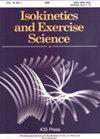The relationship between jumping, acceleration, change of direction, and relative strength for deadlift and back squat
IF 0.7
4区 医学
Q4 ENGINEERING, BIOMEDICAL
引用次数: 0
Abstract
BACKGROUND: Deadlift (DL) and back squat (BSQ) are considered different exercises because of their kinematic and kinetic characteristics. However, there are similarities, such as joint movement and the maximal muscle strength generated. Although there are differences and similarities, it is unclear which is more related to athletic performance. OBJECTIVE: This study aimed to determine the relationship between DL and jump, acceleration, and change of direction and compare whether DL or BSQ differ in their relationship to jumping, acceleration, and change of direction. METHODS: Eighty male volleyball players (age: 19.6 ± 0.9 years, height: 179.2 ± 6.7 cm, mass: 71.9 ± 9.4 kg) volunteered to participate in this study. Countermovement jump (CMJ), 10-m sprint, and 1–5 repetition maximum (1–5 RM) BSQ were measured on day 1. The T-test and 1–5 RM DL were measured on day 2. RESULTS: DL had a significant and moderate relationship with all parameters of CMJ (r= 0.328, p< 0.01), 10-m sprint (r=-0.471, p< 0.01), and T-test (r=-0.441, p< 0.01). BSQ showed a significant and moderate relationship with the 10-m sprint (r=-0.489, p< 0.01) and T-test (r=-0.356, p< 0.01), but a significant and weak relationship only with CMJ (r=- 0.289, p< 0.01). In addition, no significant differences were found in the comparison of correlation coefficients (p> 0.05). CONCLUSIONS: Deadlift may be introduced as an alternative exercise to BSQ when there are limitations in the training environment, such as the lack of a squat rack to safely perform BSQ or home confinement due to external factors like pandemics.在硬举和后蹲中跳跃、加速、方向改变和相对力量之间的关系
背景:硬举(DL)和后蹲(BSQ)被认为是不同的运动,因为它们的运动学和动力学特性。但也有相似之处,比如关节运动和产生的最大肌肉力量。尽管有差异和相似之处,但尚不清楚哪一个与运动表现的关系更大。目的:本研究旨在确定DL与跳跃、加速和改变方向的关系,并比较DL与BSQ在跳跃、加速和改变方向的关系上是否存在差异。方法:80名男子排球运动员(年龄:19.6±0.9岁,身高:179.2±6.7 cm,体重:71.9±9.4 kg)自愿参加本研究。第1天测定逆动作跳跃(CMJ)、10米冲刺和1 - 5次重复最大值(1 - 5 RM) BSQ。第2天进行t检验和1-5 RM DL测定。结果:DL与CMJ (r= 0.328, p< 0.01)、10米冲刺(r=-0.471, p< 0.01)、t检验(r=-0.441, p< 0.01)各参数均有显著、中度相关。BSQ与10米冲刺(r=-0.489, p< 0.01)和t检验(r=-0.356, p< 0.01)呈显著、中度相关,与CMJ呈显著、弱相关(r=- 0.289, p< 0.01)。相关系数比较差异无统计学意义(p < 0.05)。结论:在训练环境受限的情况下,例如由于传染病等外部因素缺乏安全的深蹲架或家中限制,硬举可以作为BSQ的替代运动。
本文章由计算机程序翻译,如有差异,请以英文原文为准。
求助全文
约1分钟内获得全文
求助全文
来源期刊

Isokinetics and Exercise Science
医学-工程:生物医学
CiteScore
1.20
自引率
14.30%
发文量
37
审稿时长
>12 weeks
期刊介绍:
Isokinetics and Exercise Science (IES) is an international journal devoted to the study of theoretical and applied aspects of human muscle performance. Since isokinetic dynamometry constitutes the major tool in this area, the journal takes a particular interest in exploring the considerable potential of this technology.
IES publishes studies associated with the methodology of muscle performance especially with respect to the issues of reproducibility and validity of testing, description of normal and pathological mechanical parameters which are derivable from muscle testing, applications in basic research topics such as motor learning paradigms and electromyography. The journal also publishes studies on applications in clinical settings and technical aspects of the various measurement systems employed in human muscle performance research.
The journal welcomes submissions in the form of research papers, reviews, case studies and technical reports from professionals in the fields of sports medicine, orthopaedic and neurological rehabilitation and exercise physiology.
 求助内容:
求助内容: 应助结果提醒方式:
应助结果提醒方式:


